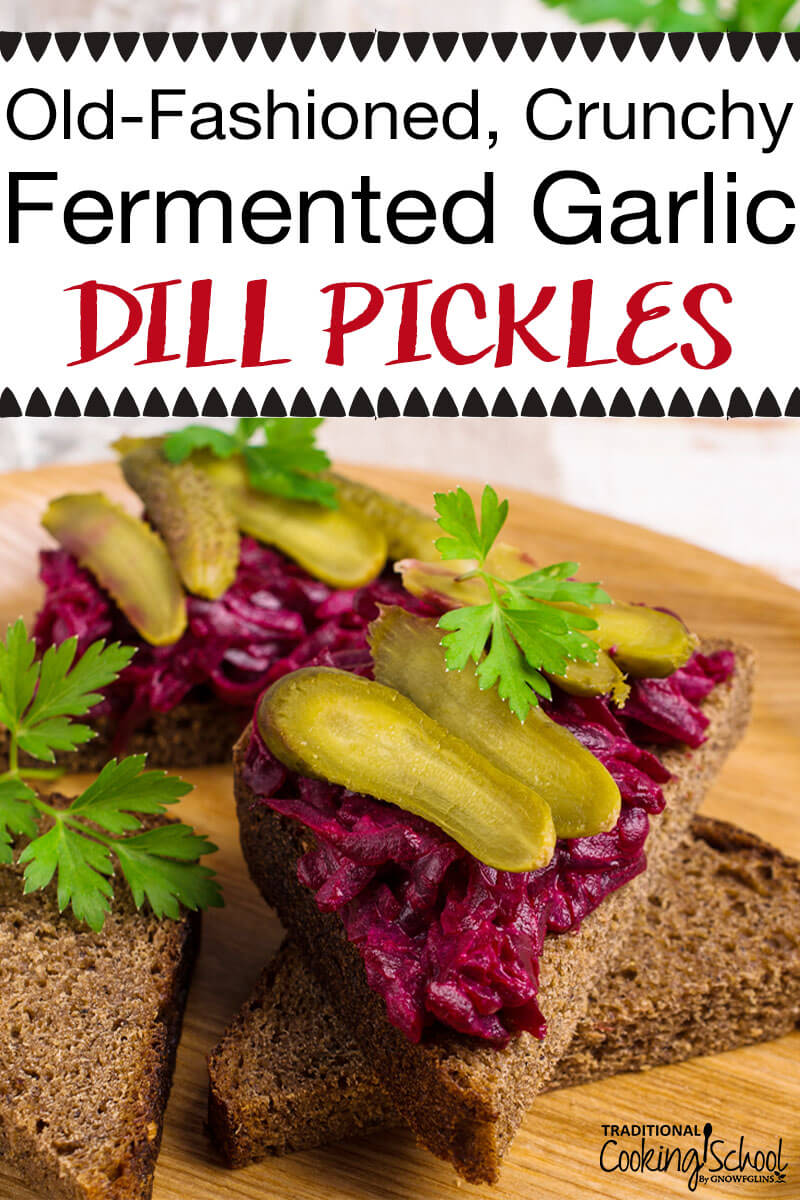
Pickles are one of my favorite ferments!
In this video, you’ll see beautiful fermented Garlic-Dill Pickles. They are so easy to make at home.
And by the way…
These are NOT your regular vinegar pickles you’ll find in the grocery store.
Nope!
Instead, these are fermented with salt. Once pickled, there’s an explosion of vitamins, enzymes, probiotics, beneficial acids, and most importantly… a delicious crunch!
These are so good, and they’re really easy to make!
Here’s the video, and below that is the written out recipe…
By the way, in the video I mentioned this FREE Fermenting Formulas Cheat Sheet — it’s a gift from me to you. Here’s a link to grab it.
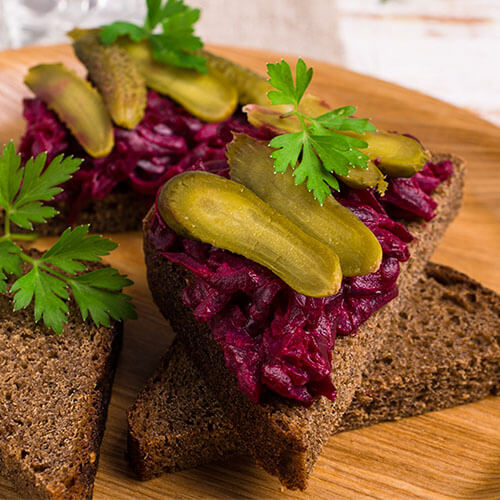
Fermented Garlic-Dill Pickles
These pickles are fermented with salt for an explosion of vitamins, enzymes, probiotics, beneficial acids, and most importantly... a delicious crunch! Makes 1 gallon pickles in this 1-gallon stoneware crock from Ohio Stoneware.
Ingredients
- pickling cucumbers or thin-skinned Mediterranean cucumbers — enough to fill the crock (I needed a few dozen) and as fresh as possible
- 1/2 gallon pure water
- 6 tablespoons sea salt
- 12 cloves garlic peeled; optional, for flavor
- 4 teaspoons dried dill seed optional, for flavor
- 1 teaspoon black tea leaves or a few fresh grape or oak leaves
Instructions
-
Submerge cucumbers in cold water for 10 to 30 minutes to crisp them up.
-
Meanwhile, make the brine by combining the water and sea salt.
-
Stir well to dissolve the salt.
-
Cut the ends off each cucumber.
-
Start packing the crock with cucumbers.
-
Every so often, sprinkle in some dill seeds, a few cloves of garlic, and some black tea. If you'd prefer, omit the dill seeds and garlic and add celery seed or peppercorns, etc. instead.
-
Keep packing the cucumbers, stopping to sprinkle more of the other ingredients along the way.
-
When the crock is full to within 3 to 4 inches of the top, stop adding ingredients.
-
Pour the brine over all of it so the cucumbers are submerged.
-
Place the stone weights on top — they will make sure the cucumbers stay below the surface of the brine.
-
Add the lid of the crock.
-
Now leave the cucumbers to ferment at room temperature for 3 to 7 days. (Shorter if temps are warmer; longer if cooler. In the video, it was winter and the house was cooler so I fermented these 4 to 5 days.)
-
When they are done, remove the lid and plates/weights. It is completely normal to see bubbles at the top and also for the brine to get cloudy.
-
Taste your pickles! They should be crunchy and salty. They may not be fully pickled through the entire cucumber but that's okay. They'll continue to "pickle" in cold storage.
-
Transfer to a gallon sized glass jar and store in the fridge. You can eat them right away or let them age longer in the fridge. Enjoy!
Recipe Notes
- Fermented with salt. Once pickled, there's an explosion of vitamins, enzymes, probiotics, beneficial acids, and most importantly… a delicious crunch!
More About The 1-Gallon Stoneware Crock
I used the 1-gallon stoneware crock kit from Ohio Stoneware in this demo.
Hands down, it’s one of my favorite kitchen tools. We ferment in it all the time — sauerkraut (video demo and recipe here), pickles, kimchi, and more.
I highly recommend it!
Thank you to Ohio Stoneware for providing it and for being such a wonderful supporter of fermented foods. 🙂
Free Fermenting Formulas Cheat Sheet
If you like this, then you’ll love my Free Fermenting Formulas Cheat Sheet.
It’s a free gift for you. It’s where I share formulas for all kinds of ferments, beverages and salsa and kraut and pickles and relish, oh yes. So you can create your own safe to eat, delicious, yummy, healthy, fermented foods.
Links You’ll Need
- 1-gallon stoneware crock kit from Ohio Stoneware — includes crock, weights, and lid
- Free Fermenting Formulas Cheat Sheet — free gift from me to you 🙂
- Sauerkraut recipe & video demo — using the same stoneware crock
Have you made old-fashioned fermented pickles? What are your favorite add-ins?
This post was featured in 60 Easy and Nourishing Picnic Recipes.
Other Fermented Recipes
- Homemade Sauerkraut In A Stoneware Crock
- Simple, No-Pound Sauerkraut
- High Vitamin C Sauerkraut
- Homemade Kimchi: An Easy Korean Sauerkraut Recipe
- Lacto-Fermented Carrot Sticks
- Lacto-Fermented Turnips & Beets
- 5-Spice Apple Chutney {lacto-fermented!}
- Spontaneously Fermented Sparkling Apple Cider {fall’s easiest ferment!}
- Homemade Raw Apple Cider Vinegar Recipe
- Fermenting Trouble Shooting FAQ’s
We only recommend products and services we wholeheartedly endorse. This post may contain special links through which we earn a small commission if you make a purchase (though your price is the same).

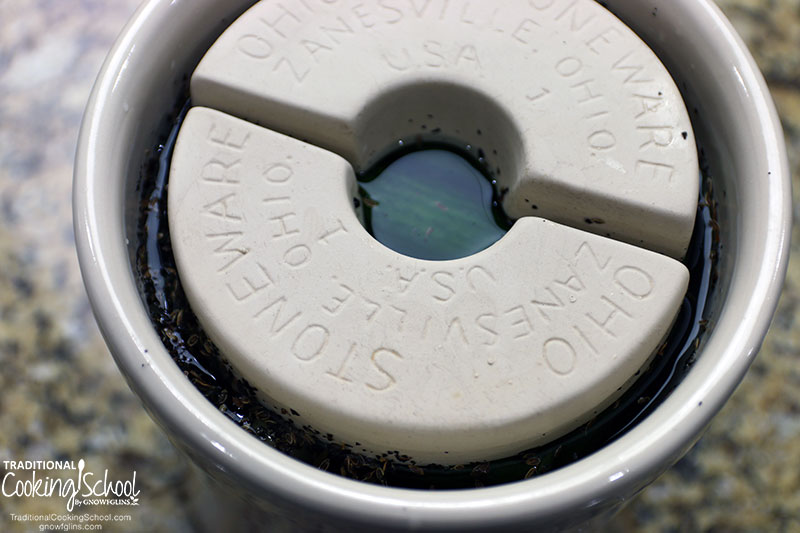
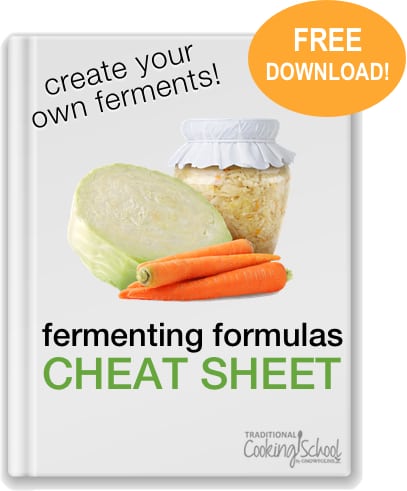

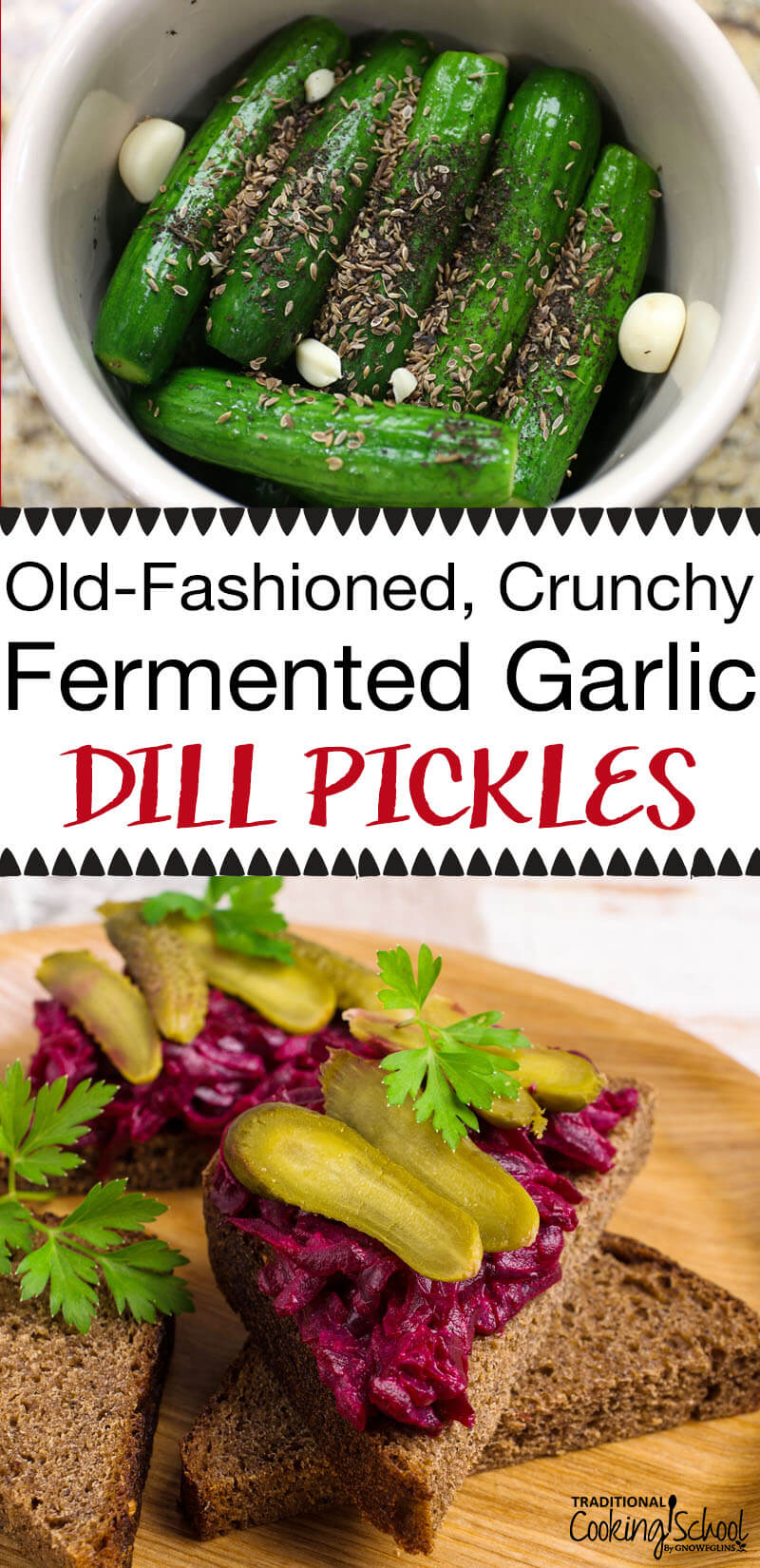
Can you use fresh dill? What about fresh sliced jalepenos? Thanks!!
Hi Stephanie,
Sure! Either of these are fine. 🙂
Millie, TCS Customer Success Team
is it necessary to use the stoneware to ferment in?
Hi James,
You can ferment in jars instead of the crock. 🙂
Millie, TCS Customer Success Team
I’ve had the greatest success in using the Fido fermentation jars from Italy, purchase through crate and barrel. I never have to burp or open the jar once it begins to ferment, Whether it’s one day for mayonnaise or five weeks for sauerkraut! So my question is, what I pack my Fido 2 1/2 L jar the same way your recipe calls for packing the stoneware gallon jar? And with the fermentation time be approximately the same? Thanks for all your great information, I am fairly new at fermenting, but enjoying the adventure!
Hi Janell,
Yes, pack the jar in the same manner. The fermentation time shouldn’t change using the jar but colder weather can take longer and warmer weather ferments quicker. 🙂
~Millie, TCS Customer Success Team
Hi there Millie Cooper. I was pleasantly surprised to see a photo of you next to the responses to questions asked. Now I know whom I am chatting to when I sent in all my questions. Love your blue jacket.
Regards Frances from Sunny South Africa
Thank you, Frances. 🙂
~Millie, TCS Customer Success Team
I’m going to do this, I normally pickle with vinegar, it seems I remember my grandparents had a huge crock in the kitchen full of pickles all the time, era 1950’s. Great article!
I have a 2 gallon Ohio stoneware crock. Can I use it for smaller batches as long as the brine covers the cucumbers and the stone weights hold them down?
Hi Ruth,
Yes, that’s perfect. Just be sure to keep them under the brine. 🙂
~Millie, TCS Customer Success Team
Can you use Horse radish leaves if so how big and how many?
Hi Rocky,
Yes, you can! Use a few larger leaves per quart jar.
~Millie, TCS Customer Success Team
These are a good flavor but rather salty. Could I use less salt?
Hi Danielle,
The salt is essential for fermenting safely and properly. A certain amount is required to protect the lactobacilli and repel spoiling organisms. If you wish to reduce the salt, make sure to use a starter culture, and also don’t reduce too much!
~Millie, TCS Customer Success Team
Hi Danielle,
I have done these for years. In my recipe I use less than half the salt from this recipe, so just under 3 Tbsp per half a galon of water.
If my pickles are large can I cut them before fermenting?
Hi Dorinda,
Yes. Feel free to cut your pickles to a size suitable for your jars. 🙂
~Danielle, TCS Customer Success Team
Hi… I have tried this once and it did not turn out… th pickles were soft an unappetizing. I am not sure where I went wrong. Temperature in my basement is around 70F. Is this too warm?
did you use kosher or sea salt?
I would say it might be a bit too warm for keeping these.
I make them very often, I don’t keep them in the fridge, but our basement is cooler by a few degrees.
Also I would make sure to boil water before use and then cool it down, and make sure you use salt with no additives.
Hello,
My husband prefers the flavor of the vinegar in pickles and I have heard from several other people that wanting the vinegar flavor is why they don’t lacto-ferment. So my question is, after the ferment could you replace part of the brine with vinegar when placing the pickles in the refrigerator? Or will that prevent the continued fermentation that is supposed to happen just a slower rate or even potentially destroy the good probiotics and bacteria. I suppose one would have to experiment to see how much vinegar
would even give the desired flavor. Just seems like there should be a way to get the best of both worlds.
Thanks!
Hi, Michelle. Are you talking about white vinegar or apple cider vinegar? I can’t really say whether or not the good probiotics would suffer or decline in the presence of apple cider vinegar (or perhaps they would shift in concentration?) but I suspect that white vinegar would cause a decline due to it’s anti-bacterial properties. I really don’t know for sure though, perhaps they would be fine unless heated. I’m sorry I can’t help more!
Thank you for your response! I was/am thinking about using apple cider vinegar because of it’s great health properties. I would rather not use white vinegar. I have a bunch of fresh cucumbers from the garden so I think I’ll half this recipe and try adding ACV after the ferment and see what he thinks. I will have more cucumbers coming so I can always make up some more if they don’t turn out. Thanks again!
I did find a recipe for lacto fermented hot sauce that adds vinegar after fermenting and blending. I will probably use my unfiltered apple cider vinegar, just a little.
Do you use fine or coarse grain sea salt? Also, can you use the brine from a previous batch of pickles as a starter culture in place of some of the salt? If so, how much brine and salt would need to be used?
Hi, Natalie,
Great questions! We use fine sea salt. Yes, you can re-use the brine 🙂
We have an AskWardee episode on this topic: https://traditionalcookingschool.com/q-a/askwardee-008-re-using-old-brine-for-new-ferments/
~Peggy, TCS Customer Success Team
Is it ok to cut the cucumbers first? Cut as is you quartered or sliced into chip sizes? Would doing so cause them to ferment more quickly or spoil more quickly?
Hi, Danielle,
Yes, you can definitely cut them first. The smaller the cut the quicker it will ferment. Each ferment is different depending on time and temperature so each ferment will last different times in the refrigerator. I usually do a small batch if I am trying something new to see how I like it and gauge how long it will last.
~Peggy, TCS Customer Success Team
Can you link the black tea you use? Is it just your basic black tea powder?
Thank you!
Hi, Curt.
We have the link above in the ingredients. Here’s what we use: https://amzn.to/2LflPcl
~Danielle, TCS Customer Success Team
I have lots of dill weed but no dill seed. Is it possible to substitute?
Hi, Toni.
Yes 🙂 Use 1/2 to same amount. People often stick sprigs of dill weed right in their pickle jars. It looks so pretty 🙂
~Danielle, TCS Customer Success Team
Hi first time doing fermented pickles. Once they are in the fridge how long do they last? Also, should I put the brine in with the pickles once transferred from the crock to the glass jar in the fridge?
Hi Hannah,
They can last in the fridge for up to a year maybe a little longer. Your pickles should always be covered in brine; whether when fermenting or when storing. 🙂
~ Vicki, TCS Customer Success Team
Great thank you! Is there a way to keep them not in the fridge? Canning etc?
I keep mine in our basement! Once they ferment, some jars even create their own seal and they keep well, without canning of course.
Hi, Hannah:
With this particular recipe and technique, you would want to store them in the refrigerator. The idea is to keep as many of the probiotics as possible. The heat from the canning process would destroy those beneficial bacteria. Sonya —TCS Customer Success Team
I forgot to cut the ends off my pickles! ? Should I take them back out and do that or just leave them alone? The jar was so pretty and so much work had been done that I hated to disturb them if it wasn’t necessary.
Hi, Shannon,
I wouldn’t cut them off, they are going to be great! 🙂
~Peggy, TCS Customer Success Team
Using 6 gallon crock….using onions, garlic, pickling spices, pickling salt….what ratio would I use…..first time I have done something like this…would appreciate your help/input….Thank You…..about 25 lbs. of cucumbers….
Multiplying the amounts for a 1-gallon cock above you could do:
1/2 gallon pure water x 6= 3 gallons
6 tablespoons sea salt x 6= 2.25 cups
12 cloves garlic peeled; optional, for flavor x 6= 72 garlic
4 teaspoons dried dill seed optional, for flavor x 6= 1/2 cup pickling spices
1-2 onions (this was not in the recipe so guessing here)
~Danielle, TCS Customer Success Team
I have the stone crock for pickling and my first batch has been fermenting for about 6 days on the counter. I looked in there today and there are lots of bubbles (which I hear are normal) but there are also little spots of mold floating on top! Did something go wrong, or is this okay?
Hi Claire, are you sure it mold? Mold is usually fuzzy and colored (green, pink, black, etc.) If so then these probably aren’t good.
However, if it is white, non-fuzzy, maybe a little stringy – that’s probably Kahm’s yeast which is perfectly fine. You can leave or spoon out.
Hope this helps. ~ Vicki, TCS Customer Success Team
I have made 2 batches and one I removed the white and once I left it in the container. I turned out better when I left it. You just have to make sure it does not get fuzzy.
I have hard well water (high in Calcium Magnesium). Can I use it instead of filtered water? Also, I have lots of pickling cucumber but they are not always small and petite. Can sliced cucumbers be fermented successfully?
I would boil the water first then cool it down.
I use varied sizes of my cucumbers. I personally have never sliced them, but it seems others have and it didn’t impact the process.
I have a different sort of question. I have a LOT of cucumbers and I have a 10 gallon crock. I was thinking of layering whole cucumbers on the bottom, a layer of horseradish leaf to separate, a layer of cucumber spears, a layer of horseradish leaves to separate then a layer of sliced cucumbers topped with a horseradish leaf. You you think this concept will work? Then when ready I can pack separately.
Hi, Lori.
Your top sliced cucumbers will likely be done first so you would be able to pull those off when they are ready and leave the rest in.
Let us know if you do it and how it works. 🙂
~Danielle, TCS Customer Sucess Team
Can I use dried dill weed? Everything I’ve read says to use fresh but where I live it is SO expensive most of the year. I don’t have dill seeds.
Hi, G,
I have not used dried dill weed before but it is worth a try. I’d make a small batch and let us know how it went! 🙂
~Peggy, TCS Customer Success Team
It’s day 3 of fermentation and I peeked into the crock. There is foam on the top (also some bubbles). Is the foam normal? Does it just get skimmed off? Thank you!
Hi, Deborah: Yes, you can skim off the foam, although it’s not harmful. You just want to be sure there’s no mold and that everything is submerged beneath the brine. —Sonya, TCS Customer Success Team
If you can Can fermented kraft, couldn’t you do the same with salt pickles?
Hi, James,
If you can ferments you lose the probiotic benefits from fermenting. When I can pickles I use a recipe that is meant for canning to assure safe canning practices. This recipe is for a raw and living pickle, I would not can this.
~Peggy, TCS Customer Success Team
Hi! I am new to fermenting and I followed this recipe except I sliced my cucumbers and omitted the garlic because my daughter can’t eat it. I am using a jar that has an airlock on it and I am going on about 48 hrs of fermenting. There’s a really strong sulfur/rotten egg smell that I can smell through the airlock – is my ferment doomed or is this normal? Also, a few of my cucumber slices have escaped from under the weights – should pull those out? Thanks for any help!
Hi! Good news, I hope, but the sulfur smell went away on day 3! I assume that means my ferment is ok? I do still have a few cucumber slices that floated to the top – should I just pull them out? Thanks again for any help!
Hi Michelle, so glad the sulfur smell went away. You could give them a try, if they taste good and smell good then they are likely fine. You can pull out the floaters if you want to.
~ Vicki, TCS Customer Success Team
Is the black tea integral to the process, or just for flavor? What if I leave it out?
Hi, Rob,
The black tea helps it to maintain it’s crunch but it is not necessary if you want to leave it out. 🙂
~Peggy, TCS Customer Success Team
Can you substitute Alum for the tea leaves? Thanks
Hi, Heidi,
Though there exist different types of alum, potassium-based alum is the main alum people use for pickling. This alum according to Wikipedia is aluminum-based. And while there is no proven link between aluminum and Alzheimer’s disease, people with Alzheimer’s do have more aluminum in their brain tissue than normal. So we do not recommend using any forms of aluminum.
It is best to use tea leaves or grape leaves and cut off the stem end of the cucumbers if using whole cucumbers.
~Peggy, TCS Customer Success Team
Hi Heidi,
You can use horseradish leaves, oak leaves or current leaves, even cherry leaves or a sprig from a tree. All of those aid in maintaining a crunch.
Is it ok if some of the dill seed floats to the top? ?
Hi, Colleen.
Yes, that’s fine. 🙂
~Danielle, TCS Customer Success Team